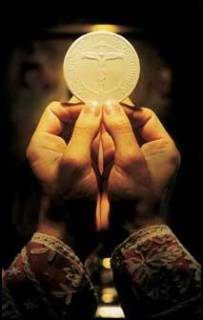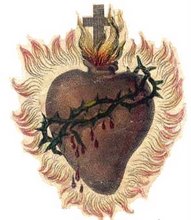What can Brown do for you?
There is a wonderful blog written by "Sister Mary Martha," who if I am not mistaken, is a religious sister, commonly known as a nun. However, there is nothing common about her! She runs an extraordinary blog that I check out very often and really enjoy. She is faithful to the Lord and His Church, witty in her commentary, and a wonderful writer. (On top of all that, she is a sister, and anyone who knows me even causally knows that I love my sisters! They are an often underappreciated gift that God gives to His Church, and we should treasure them as such.)
So, with her permission, I am stealing a blog of hers, "What can Brown do for you?" It is about a most important Catholic sacramental called the 'scapular'. I realize that this may get my seperated brethren in a tizzy, but I hope they read this with an open mind, learn what the Church actually teaches on sacramentals, and enjoy Sister's sterling sense of humor.
I wear a scapular, and would invite every Catholic to do the same. It is a wonderful reminder of Our Lady's love for her children and our invitation to eternal happiness through everyday holiness.
(One more special thanks to Sister, as I was asked to write a blog on the scapular a while ago, and haven't found the time.)
God love you!
************
I'm glad to have the opportunity to explain more about sacramentals, which seem to drive many people around the bend. I hope those who have been driven around the bend by sacramentals and the questions about them are offering up their suffering. It IS LENT.
We've had quite the discussion about the Brown Scapular.
One reader wants to know:
I am I to understand that as long as I wear the brown scapular (provided it doesn't fall off), I get to heaven even if I deny the Trinity, the Real Presence and Christ's Redemption by the Cross?
I really have to ask a question in return. If you deny the Trinity, the Real Presence and Christ's Redemption by the Cross, why on earth would you run around in a scapular all day every day? Clearly, you have no fear of hell in the first place.
But fine, for the sake of argument, let's pretend someone would do that. (We can do that while we're pretending the bones of the Jesus Family have been found and identified.)
Here's how I see it. Keep in mind I am an old nun that taught Catechism to second graders.
1. Our Lady made the Brown Scapular promise in direct reference to people who had devoted their lives to Christ and His Church. The Brown Scapular to which she refers is a part of their habit. So the promise already refers to the faith. She could have phrased it this way, "All you Carmelites will not see the fires of hell."
2. The Pope extended the promise to the rest of us, meaning, the Church Militant...which means, we believe the same thing. He didn't extend the promise to the separated brethren or the Wiccans.
3. As an old nun who taught Catechism, do I believe that you could be a Catholic believer, yet lead a sinful life and still not see the fires of hell because you wore a Brown Scapular? You bet I do! God can do anything He wants, including honoring Mary's hair-brained promises. God likes to cut people some slack whenever the opportunity arises. Perhaps Mary in her Motherly wisdom realizes that you have to look at that thing and shower with that thing and wear your prom dress with that thing every day of your life and that just maybe that will be enough of a reminder for you to dial it back and straighten up and ask for forgiveness. Like when Jimmy Cagney looks at a picture of his sainted mother while he's in the pokey and he's sorry for the sorry life he has led. So touching. These things happen.
Do you have to believe this? No, you don't.
4. Do I think if you wear a Brown Scapular and lead a sinful life and are not sorry ever but just run around saying, "Ha ha, I'm wearing a brown Scapular! Satan will never get me!" that you won't see the fires of hell? Not a chance. Satan already has you. The one time you take it off to shower, you'll slip on the soap and crack your head open. The bus that knocks you out of your shoes will knock you right out of your scapular. The flood waters that wash you away will wash the scapular off your neck. Your evil boyfriend will remove it while you sleep and murder you for your jewels. The paramedic will take it off to give you a shot of adrenaline that doesn't work. The nursing home worker will steal it from you. The atomic blast will vaporize the Scapular one millisecond before it vaporizes you. As you tumble, end over end, down the basement stairs with no one home to hear all the thumping, your scapular will be tossed off and land right before your eyes along with you at the foot of the stairs. As the life drains from you as you lay bleeding from your head wound, you will reach pathetically for your scapular, but the cat will grab it and run out the basement window. At some point, you are going to want to throw it in the wash. When you do, you'll drop dead.
You are not going to get away with it, mark my words.
From another reader:
The point I am trying to make is that when catholics make claims about sacramentals without giving the whole story, non-catholics easily fall into the "Catholics aren't Christian. Catholics are idolators" and a whole bunch of other stuff. I have to frequently explain to non-catholic friends the ideas of sacramentals, praying 'to' saints, and 'worshipping' the Blessed Virgin.
I have to do that all the time too. Offer it up. It's a great opportunity to set the record straight.
From yet another reader, this crackpot idea ( I had to correct some spelling):
Got to love how we try to secure salvation through any means possible, regardless of how puerile or ridiculous it is. How can a piece of cloth guarantee salvation? What are we, Hindu?
Along these same lines of superstitious, pagan left-overs in the Church, the Eastern Orthodox have numerous nifty wearable items and prayers to guarantee just the thing you need! Sure glad the church thought of everything. 100% money back guarantee, just like Folsom Lake Ford. Except this time it'll be too late to go spend your money.
The piece of cloth is a symbol of what we believe. You don't need the symbol to believe it. You can dump all your sacramentals and saint holy cards into the landfill tomorrow. No problem. You can forget about wearing a scapular. You don't have to believe in anything that came to us through private revelations: scapular, the Miraculous Medal, the St. Gertrude prayer...let it all go, no problem.
I may suggest also that you rid yourself of your family album and all those videotapes of the kids when they were little and the keepsake opal ring that belonged to your Grandmother because.... who needs reminders? What are we Hindu?



